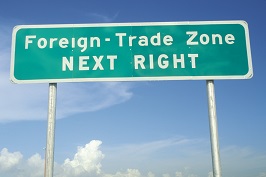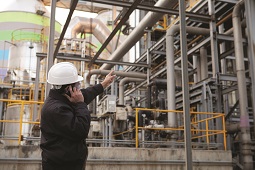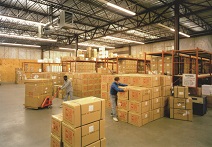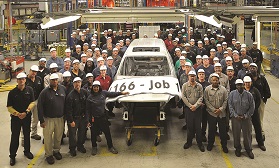
 As a result of a rewrite of federal regulations in 2012, many U.S.-based businesses will now find access to the U.S. Foreign-Trade Zones (FTZs) program faster and easier. U.S. Foreign-Trade Zones are used by hundreds of companies to enhance the competitiveness of their U.S.-based manufacturing and distribution operations through the reductions in Customs duty costs that the Zones program offers. Zone projects are established in more than 200 American communities to support economic activity in their locales that, if not for the FTZ program, might otherwise be conducted more cost-effectively overseas. Since the FTZ program was instituted in 1934, the federal government’s mandate has been to see that it is used to help U.S.-based businesses engaged in international trade activities level the playing field versus their overseas competitors.
As a result of a rewrite of federal regulations in 2012, many U.S.-based businesses will now find access to the U.S. Foreign-Trade Zones (FTZs) program faster and easier. U.S. Foreign-Trade Zones are used by hundreds of companies to enhance the competitiveness of their U.S.-based manufacturing and distribution operations through the reductions in Customs duty costs that the Zones program offers. Zone projects are established in more than 200 American communities to support economic activity in their locales that, if not for the FTZ program, might otherwise be conducted more cost-effectively overseas. Since the FTZ program was instituted in 1934, the federal government’s mandate has been to see that it is used to help U.S.-based businesses engaged in international trade activities level the playing field versus their overseas competitors.
For more than 75 years, local Zone project grantees have been responsible for delivering the FTZ program to members of their respective business communities. The Foreign-Trade Zones Board, which oversees the program on a national basis, is responsible for issuing grants of authority that enable individual companies to use FTZ procedures under the auspices of their local grantee organizations.
Since its inception, the Foreign-Trade Zones program has seen a number of crucial developments. In 1950, the Foreign-Trade Zones Act was amended to allow manufacturing activity within Zones. In 1973, the U.S. Court of International Trade issued a ruling that upheld the Foreign-Trade Zones Board’s legal authority to establish so-called “subzones” to provide access to the FTZ program for companies not located within the boundaries of existing Zones. In 1980, a U.S. Treasury Decision determined that the “value added” in FTZ production activities (i.e., domestic labor, materials, overhead or profit) is not included in the dutiable value of manufactured goods when they enter U.S. commerce. These three developments prompted tremendous growth in the use of the program during the 1980s, notably in the automotive manufacturing sector.
However, growth in the use of manufacturing subzones in the 1980s raised questions in the minds of some, particularly those who were concerned that one particular benefit – that of relief from so-called “inverted tariffs” – might result in less, rather than more, U.S.-based economic activity. An “inverted tariff,” also known as an “irrational duty rate relationship,” exists when the duty rate applied to an import of a particular manufactured product is lower than that applied to one or more of its imported components. This kind of duty rate relationship suppresses the operating margins of U.S.-based manufacturers.

The response of the FTZ Board was to publish a new set of regulations that clearly outlined its evaluation of FTZ applications, especially those for subzones and those that sought relief from inverted tariffs. Those regulations were promulgated on October 8, 1991. The 1991 regulations mark the transition between FTZs as “place” to FTZs as “trade program.” Under previous FTZ Board regulations, the in-depth specifics of Zone-related activity – and the accompanying benefits – were more or less defined by the concept that Zones were areas in which merchandise was treated as if it were outside U.S. Customs territory. While this concept continued to exist under the 1991 regulations, more specific definition of operations became essential in any company’s proposed use of Zone procedures. Beginning with the 1991 regulations, the FTZ Board’s evaluation process required much more detailed information, including specific imported components (along with their tariff classifications and duty rates); finished (or, in some cases, intermediate) products and their duty rates; the extent of domestic production versus export production; the extent of foreign competition; and the possible use of imported components that may be subject to trade restrictions. Under the 1991 regulations, the FTZ Board took a more detailed approach to evaluating requests for FTZ manufacturing authority to make sure that in granting such authority, the result would be more U.S.-based value-added activity rather than less. In the 1991 regulations, the “burden of proof” threshold for establishment of a subzone is specifically stated as “significant public benefit.”
However, the 1991 regulations offered only limited means by which a company entering the Zones program could have its application reviewed on an expedited basis. For the most part, the caravan of companies wishing to use the FTZ program were obliged to abide by the process and timeframes of those companies whose cases might be most problematic. Thus, like the proverbial caravan with its slowest camel, simpler FTZ applications tended to move at the same pace as more problematic ones. To assure that it was protecting the public interest, the FTZ Board regulations of 1991 codified what might be thought of as a “lowest common denominator” application processing regime.

NAFTA brought new investments in value-added production facilities to North America. Companies evaluating locations for new North American plants typically analyzed and compared any and all cost-of-production factors that might affect their prospective operating margins. Included in their analyses were the Customs duty regimes in each of the three NAFTA countries: the USA, Canada and Mexico. The U.S. FTZ program’s benefit of relief from inverted tariffs became particularly important in light of the NAFTA treaty’s “Restrictions on Drawback and Duty Deferral Programs.” In a number of cases, the U.S. Foreign-Trade Zones program was in a position to offer a cost-of-production structure that favored location of a new North American plant in the USA – but only if access to the FTZ program could be practically realized in a timely manner.
The Uruguay Round tariff structure created a number of new irrational duty rate relationships (inverted tariffs). This impelled a number of existing U.S.-based companies to operate under a tariff structure that was no longer benign or positively biased toward U.S.-based production; it impinged on their operating margins. To adjust to the new tariff structure, they needed access to the U.S. FTZ program – and sooner rather than later.
In expanding the so-called “Weekly Entry” procedure, which had previously been reserved for FTZ production operations, the Trade and Development Act of 2000 made the FTZ program of practical benefit for U.S.-based distribution operations. As a matter of course, distribution operations began to approach their local grantee organizations seeking access to the FTZ program. In a number of cases, easy access was problematic. One problem was the “significant public benefit” threshold for the establishment of subzones. In 1991, the term “subzone” connoted a manufacturing operation with a high value-added quotient. Distribution operations, which are more typical of General-Purpose Zones, have a lower value-added quotient, and, under the 1991 regulations would have a tougher time in meeting the “significant public benefit” standard. Discussions with grantee organizations around the country prompted the FTZ Board staff to develop a means by which General-Purpose Zone status could be brought to members of local trade communities more quickly and easily. On May 8, 2008 the FTZ Board’s proposal for an “Alternative Site Management Framework” for local Zone projects was published in the Federal Register. After two rounds of public comments, the option for local grantees to operate under the Alternative Site Management Framework was adopted by the Board on January 12, 2009.

One can look back to 2004 to see evidence of their work. On April 5th of that year, the Board published proposals to facilitate the use of FTZs by small and medium-size manufacturers. Those proposals, which created a two-track basis for FTZ manufacturing and processing authority, were formally adopted on August 30, 2004. So-called Temporary/Interim Authority (also known as “T/IM”) allowed smaller business that conducted manufacturing and processing activities identical to those that had been approved by the FTZ Board within the previous five years to avail themselves of an expedited review process that would enable them to enjoy FTZ benefits sooner rather than later. Unfortunately, relatively few companies (28) qualified for and were granted T/IM authority under its very specific parameters between 2004 and 2012.
In searching for a more expansive solution to the “one size fits all” regime imposed by the 1991 regulations, the FTZ Board staff came to the realization that a truly effective solution would require a new set of FTZ Board regulations. On December 30, 2010, a Federal Register Notice of an entirely new set of Foreign-Trade Zones Board regulations was published. After one round of public comment, the Board adopted the comprehensive rewrite of its regulations on February 28, 2012. Included in the new regulations are criteria by which non-controversial applications for FTZ production authority can be subjected to public comment, evaluated and approved within 120 days from receipt by the FTZ Board, while those that are more problematic remain subject to the same timeline and evaluation process as required by the 1991 regulations. The early results of the new two-track application process would appear definitive. In the first 17 months since the new regulations were adopted, the FTZ Board staff evaluated, processed and authorized 43 “Production Notifications” for U.S.-based production operations on an expedited basis – nearly double the number of T/IM approvals over that regime’s eight-year lifespan.
Clearly, this offers a real advantage to the American business community and the grantees who deliver the FTZ program to it. One might also argue that these new expedited review procedures created by the new regulations represent an example in which the U.S. government has taken the initiative in responding to the real needs of American communities and businesses by changing its own rules.
Rick Tucker, executive director of the Huntsville-Madison County Airport Authority, grantee of the Zone project in Huntsville, Alabama, expressed his opinion on the new application review procedures by stating, “Our organization functions as a regional economic engine. This makes it important for us to efficiently deliver services and programs that enhance businesses’ competitiveness. Under the new FTZ Board application review processes, our Zone now has one application for FTZ Production Authority being evaluated on the standard timeframe track, and one subzone application being evaluated on under the new expedited rules. We also have two more future applicants who will also be eligible for expedited review.” He added, “I think it is important for federal agencies such as the FTZ Board to give community-based organizations such as FTZ grantees the flexibility that best enables them to deliver the help their local businesses need in order to compete in today’s global economy.”

